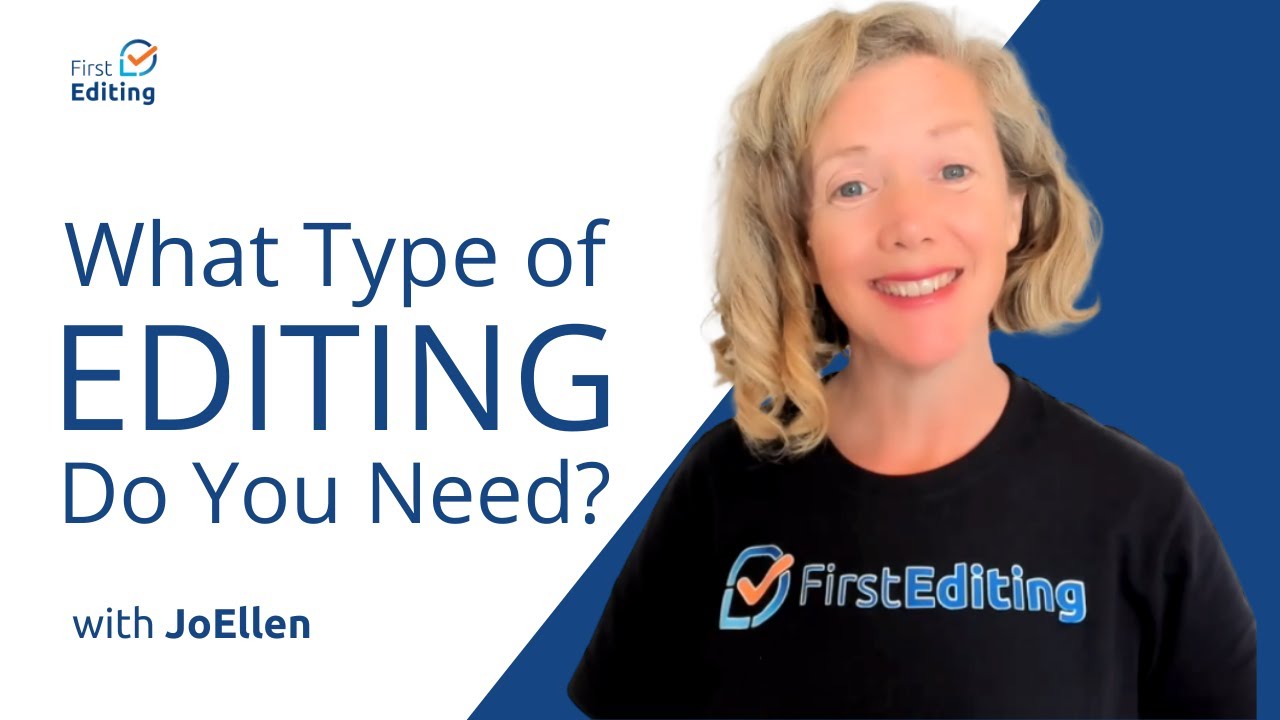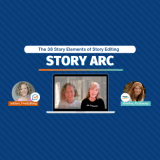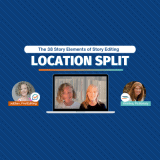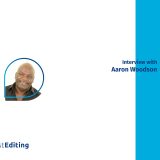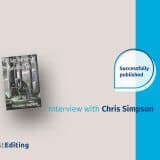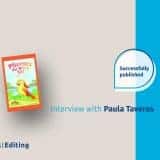
Without an editor, you won’t necessarily see those things that are there, or you won’t think that they need fixing. Fictionary is one of the editing tools that bring out the best in your work.
In this episode, Kristina from Fictionary joins JoEllen as they continue with this quartet interview together with Lisa and Tara as she shares how Fictionary can help you with your Editing.
Why is it important for an author to do a story edit on Fictionary?
Fictionary storyteller is for writers and it’s for them to self edit their novel from a high-level story perspective, and it becomes important if you think of writing a novel is like any other art, you need to learn the craft behind the art and the form of it if you want to do something spectacular with your story. And so what fictionary is designed to do is to show a writer what they need to look at on a per scene basis. And I very carefully say form there, because it’s not a formula. It’s more of a guide.
There are, of course, fiction rules and writers can break them, but only once they know them and understand that they’re breaking them and don’t break them by accident. And so what we’re hoping to do with Fictionary is to teach them what goes into a great story. And so, as they edit their first draft within fictionary, then they learn all the basics on a personal basis. And once they know that, then the next novel they write is going to be much easier because it’s ingrained in their head. And so the feedback we get from our subscribers is really it’s a great learning process. And because it’s so organized and enables them to do things to avoid what Miss Lisa did with putting writing a novel and not finishing it. Because often a person writes a draft and by draft I mean, you’ve written a story that’s gotten all the way to the climax and a resolution. So there’s some sort of story there. And then it’s overwhelming because you get it, you have a big MS Word or Google Docs document.
And there’s your 80,000 words, what do you do with that? And so Fictionary points, you’re on every scene what to do with every scene. And so the writer can actually finish their story, and it will be better.
How do storyteller users, the ones that are actually using that software themselves? How do they best benefit from a certified story coach?
The reason why the Story Coach Software and the Fictionary certified story coach program was created was that we found there were too many writers out there, one not knowing what they should get from a story editor, and not really getting a full story at it. And the other problem is for editors to do a story at it, it’s very time-consuming. And so what the story coach is doing is it’s helping the editor be comprehensive, so they cover everything, it’s helping them do it quickly. So they can actually do a job and teach the writer at the same time. And when a story coach editor, like all of the editors at first editing are all certified, when those editors do an edit, what they do is they create an account for a story coach for the writer. And the writer then not only gets the edit, and they can see all of the visuals and the comments on a personal basis. They also get writing advice. So if they don’t understand what the editor said, or they need more information, there’s writing advice for the writer right in there.
And so it follows up behind the editor. And what a story coach editor then do, is provide an extreme amount of information to a writer. And so it’s not a one kind of it’s a handoff, and then you’re on your own as a writer, the writer is left with a tool to really utilize what the editor is saying. The other benefit is, the writer can see the impact of the editor’s comments on their story. So as they revise the story arc, continually redraws and the word can proceed. And they can see their story getting better. So the writer has confidence that the editor has done a great job. And the editor has confidence, they’ve done a great job and not influenced the readers’ voice or story intent because the story coach keeps them on track and super focused.
One of the things that we love as story coach editors, is that all of the edits are right in line so you can see them, there’s no cross-reference with that the letters and the notes, annotation, it’s right there. So you can go through it and it’s very much a checklist of everything that have to catch. And of course, the storyteller gives you all the information. So we’re getting back to that same level where we can talk together.
Why did you want to add those elements when people are doing their story at it?
Yeah so two things on your question one, I’m just gonna pop up something that JoEllen has often said, it’s like a pilot’s checklist before they take off. Right? That the pilot is fully professional, knows how to fly a plane, and yet they go through a checklist every single time to make sure they haven’t missed something. And that’s what you’re talking about.
So you can choose to ignore it if you want, but it’s kind of in your face that maybe you should look at it. So it’s JoEllen’s analogy that I just like to steal from her because it’s really good. And so the visuals, I started that because when I wrote my books, I had four of them and I had these spreadsheets and I was drawing them in excel. And so I was counting my word count per scene and then drawing it out. So I could see it I was, I was using word count to go, okay, this person is in. So where’s my inciting incident, and it was taking me forever. And you think, well, this is just frustrating, right?
So we put the visuals in so that the writer can see their story. And you can change it around. If you don’t agree, you know, we use natural language processing to scan and evaluate the manuscript. So as you know, it’s close, but it may need to be altered a little bit. So the writer has a choice, and they can update the key scenes and things as they see fit. But as they revise, they can see that their story arc is filling into the right place. And again, I stress a story arc is a form. It’s been around since the beginning of time and hasn’t changed.
So all of these successful stories movies, it has follow the same general story arc. And so as a writer, it’s important to know what it is, you can always do something different. But if you understand why it’s there in the first place, then you’re deciding on an educated knowledge base of how to change it. So the visual is really there. The word count per scene. And the scenes per chapter will really show a writer what their structure looks like, and want to dwellings editors just edited a book where she shared the word count proceeding, and asked him, we were just discussing about what’s, what’s the best way to help the writer and the word count per scene was showing the writer had all of their scenes between 500,000 words, and they had a 7000-word scene in there. And it made the story arc look really odd, because it doesn’t fit the form. And then, you know, and so the advice was to go back and look through the scene for scene breaks, where you could break it out and make it more manageable for the reader. Because 7000 words is really long for one scene where you might be reading on your phone. And then the chapters or the scenes per chapter help the writer figure out the theming of their chapters. And why did they put a specific scene with a certain chapter? Why wasn’t it in the next chapter? Why was it grouped at all, and they can see it and look at it again, one of the books had one chapter with 19 seats, and the rest of them had 1 to 3. So there’s an imbalance there, and the reader is going to go, what is this? It’s odd, it’s gonna stick and they won’t know why this chapter is dragging, but there’s a reason. So the visuals, you know, and that’s just three of them. There’s, there’s 13, and all, but they just help the writer see the book in a different way. And then they can make adjustments to fix it and understand why they’re fixing it.
Yeah, I feel like it lets you look at the big picture, you can see the whole forest instead of just the individual trees because you’re standing at the edge of a forest, you can just see, you know, the trees that are right in front of you. But being able to like back up and get that high-level look at it is so important. Because then you can see how things are in relation to each other and where, where things aren’t fitting in. Because even if readers don’t really realize that they’ve gotten used to the rhythm of a book, I think it happens. And so if the rhythm of a book is three scenes, three scenes, four scenes, three scenes, and then it’s 12 scenes, there’s, there’s your readers is getting ready for the end of something and then it doesn’t, it doesn’t come and it’s like weirdly unsatisfying.
It is and it is weirdly unsatisfying. That’s exactly what it is and the reader and they might not come back to your book because of it. And that’s terrible. Especially if it’s a good story, right? Then you think all that is structure change, not big story changes that can just very quickly improve the story.
And it comes down to making everything reader-centric again, which is something we talk about a lot of ProWriting Aid. Now, if we’re not suggesting in most cases, that people change the story elements and the key parts of their narrative, what what you’re suggesting, and what we’re suggesting with a lot of our reports is changing the delivery elements of it so that, you know, everything’s still there. You’re just helping your reader to understand and digest and take the story from, you know, from the pages of your book into their brain in the easiest, smoothest way.
Yeah, and that kind of leads back to JoEllen’s question about story coach editors, and their editors know when they’re looking exactly what you’re saying for the writer. The editor is going to do that as well and has the same advantage of it. So they’re not influencing the writers’ voice are intense. And it just it’s hard to do that as an editor if you’re just using a big word document, but when you can actually see it and understand it. You can see If you’re influencing their intent in their voice, and so it helps the editor as well just help the writer. All part of the same process.
Subscribe and follow along and you’ll get all the information in the writing industry.




